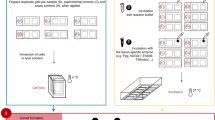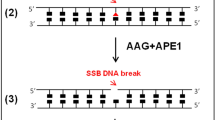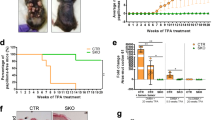Abstract
Since the pioneering work of the Millers1 it has become clear that most chemical carcinogens require metabolism to reactive electrophiles and then exhibit their carcinogenic potential by reacting chemically with, and modifying, cellular macromolecules. At first modification of proteins was considered most likely to be of importance in carcinogenesis. Later, Brookes and Lawley2 demonstrated that the extent of binding of several polycyclic hydrocarbons to DNA, but not to RNA or protein isolated from the skin of mice treated topically with these compounds, correlated with their known carcinogenic potency to this tissue. Mammalian cells, particularly mouse embryo cells, treated with chemical carcinogens have often been used, and DNA has been involved almost exclusively from whole cells. However, mitochondria possess unique DNA which accounts for 0.1–1% of the total DNA present in mammalian cells3, and three studies have shown that carcinogenic alkylating agents modify the mitochondrial DNA by a factor about five times greater than the nuclear DNA from the same cells4–6. We demonstrate here that with six polycyclic aromatic compounds, all of which require metabolic activation and bind to DNA to a much smaller extent than direct-acting alkylating agents, the binding to mitochondrial relative to DNA is dramatically increased by a factor of nearly 50 to over 500.
This is a preview of subscription content, access via your institution
Access options
Subscribe to this journal
Receive 51 print issues and online access
$199.00 per year
only $3.90 per issue
Buy this article
- Purchase on Springer Link
- Instant access to full article PDF
Prices may be subject to local taxes which are calculated during checkout
Similar content being viewed by others
References
Miller, E. C. & Miller, J. A. Cancer Res. 7, 468–480 (1947).
Brookes, P. & Lawley, P. D. Nature 202, 781–784 (1964).
Nass, S. Int. Rev. Cytol. 25, 55–129 (1969).
Wunderlich, V., Schütt, M., Bottger, M. & Graffi, A. Biochem. J. 118, 99–109 (1970).
Wunderlich, V., Tetzlaff, I. & Graffi, A. Chem.-Biol. Interactions 4, 81–89 (1971).
Wilkinson, R., Hawkes, A. & Pegg, A. E. Chem.-Biol. Interactions 10, 157–167 (1975).
Prescott, D. M., Tao, M. V. N., Evenson, D. P., Stone, G. E. & Thrasher, J. D. in Methods in Cell Physiology Vol. 2 (ed. Prescott, D. M.) 131–142 (Academic, New York, 1966).
Miyaki, M., Yatagai, K. & Ono, T. Chem.-Biol. Interactions 17, 321–329 (1977).
Diamond, L., Defendi, V. & Brookes, P. Cancer Res. 27, 890–897 (1967).
Hirt, B. J. molec. Biol. 26, 365–369 (1967).
King, E. J. & Wotton, I. D. P. Micro-analysis in Medical Biochemistry 3rd edn, 76 (Churchill, London, 1956).
Hill, B. T. & Whatley, S. FEBS Lett. 56, 20–23 (1975).
Phillips, D. H., Grover, P. L. & Sims, P. Int. J. Cancer 22, 487–494 (1978).
Sato, R., Atsuta, Y., Imai, Y., Taniguchi, S. & Okuda, K. Proc. natn. Acad. Sci. U.S.A. 74, 5477–5481 (1977).
Raw, I. Biophys. biochem. Res. Commun. 81, 1294–1297 (1978).
Graffi, A. Z. Krebsforsch. 49, 477–495 (1940).
Coombs, M. M., Bhatt, T. S. & Young, S. Br. J. Cancer 40, 914–921 (1979).
Coombs, M. M. & Croft, C. J. Prog. exp. Tumor Res. 11, 69–85 (1969).
Sims, P., Grover, P. L., Swasiland, A., Pal, K. & Hewer, A. Nature 254, 326–328 (1974).
Coombs, M. M., Kissonerghis, A.-M., Allen, J. A. & Vose, C. W. Cancer Res. 39, 4160–4165 (1979).
Borst, P. & Grivell, L. A. Cell 15, 705–723 (1978).
Warburg, O. Science 123, 309–314 (1956).
Egilsson, V., Evans, I. H. & Wilkie, D. Molec. gen. Genet. 174, 39–46 (1979).
Coombs, M. M. J. labelled Comp. Radiopharm. 16, 147–151 (1980).
Author information
Authors and Affiliations
Rights and permissions
About this article
Cite this article
Allen, J., Coombs, M. Covalent binding of polycyclic aromatic compounds to mitochondrial and nuclear DNA. Nature 287, 244–245 (1980). https://doi.org/10.1038/287244a0
Received:
Accepted:
Issue Date:
DOI: https://doi.org/10.1038/287244a0
This article is cited by
-
Effects of exposure to environmental pollutants on mitochondrial DNA copy number: a meta-analysis
Environmental Science and Pollution Research (2022)
-
The effects of everyday-life exposure to polycyclic aromatic hydrocarbons on biological age indicators
Environmental Health (2020)
-
A prospective study of mitochondrial DNA copy number and the risk of prostate cancer
Cancer Causes & Control (2017)
-
Regulation of metastasis; mitochondrial DNA mutations have appeared on stage
Journal of Bioenergetics and Biomembranes (2012)
-
QPCR: a tool for analysis of mitochondrial and nuclear DNA damage in ecotoxicology
Ecotoxicology (2010)
Comments
By submitting a comment you agree to abide by our Terms and Community Guidelines. If you find something abusive or that does not comply with our terms or guidelines please flag it as inappropriate.



